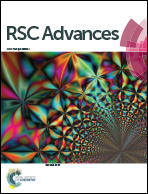Exclusive excited state intramolecular proton transfer from a 2-(2′-hydroxyphenyl)benzimidazole derivative†
Abstract
The excited state intramolecular proton transfer (ESIPT) of a newly designed 2-(2′-hydroxyphenyl)benzimidazole derivative (bis-HPBI), has been investigated in different nonpolar, polar aprotic, and polar protic solvents. Unlike 2-(2′-hydroxyphenyl)benzimidazole, it exhibits exclusive ESIPT even in protic solvents. The existence of trans enol was made unviable by crafting a steric hindrance that stops the normal emission of bis-HPBI. Though bis-HPBI has two HPBI units, the tautomer emission of bis-HPBI is due to only single proton transfer. The experimental studies and theoretical calculations corroborate the finding. Protonation and deprotonation studies on bis-HPBI are also performed. The enhancement in the tautomer band intensity upon deprotonation of one of the OH groups also supports the single proton transfer in bis-HPBI. On the other hand, the initial addition of acid quenches the tautomer emission by hydrogen bonding interactions. After protonation of imidazole nitrogen, bis-HPBI acts as a photoacid. The dissociation of ‘OH’ protons and reorganization of the molecule leads to partial recovery of tautomer emission. In a strongly acidic medium where deprotonation of the ‘OH’ group is not possible, the emission is observed from the cation of bis-HPBI.


 Please wait while we load your content...
Please wait while we load your content...